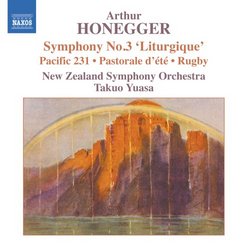Sterling Honegger from New Zealand
J Scott Morrison | Middlebury VT, USA | 11/15/2004
(5 out of 5 stars)
"I'm a latecomer to the appreciation of Honegger's music. With the exception of such things as the Fourth Symphony ('Deliciae Basiliensis,' an urban night-piece the equal of Vaughan Williams's 'London Symphony,' and 'Pastoral d'Été,' in a classic recording by Hermann Scherchen) I've known little of his music until fairly recently. I credit a friend whose judgment I admire and who kept after me about my having called Honegger a 'gray composer' that I've come to value much of his that I've heard in recent years. I've made up for lost time, but I'm far from an expert on his output yet. Still, I've heard the Karajan and Munch recordings of his Third Symphony and was pretty familiar with the work when this new release came my way.
Honegger wrote two war symphonies, the Second (1941) and this one, the Third (1945). Both depict the horror of war and each ends with some hope for the future, although I must admit that Honegger was clear-eyed about the after-war period not being all moonlight and roses. The Third, subtitled 'Liturgique,' is not actually a religious symphony in the usual sense of the word. Rather it uses Latin phrases from the liturgy to describe the feeling of each of its three movements: 'Dies irae,' 'De profundis clamavi' and 'Dona nobis pacem' ('Day of Wrath,' 'Out of the Depths We Cry,' and 'Give Us Peace'). The first movement is a furious allegro that is hard-edged and even ugly at times. This is angry, anguished music. The second, an adagio, is a heartfelt cry of supplication. The third is a bit calmer but still has more than a little resignation and cynicism about it, even though a kind of uneasy quiet is achieved at the end. There is one theme that occurs in all three movement, one that Honegger called 'the bird theme' and it can be thought of as representing the dove of peace. It is quoted in its most serene form at the end of the piece, but there is still the unease of diffidence about it. No wonder; Honegger's Fifth Symphony, the last he wrote, returns to this anguished outcry. Takuo Yuasa and his New Zealand Symphony Orchestra, in superb modern sound, turn in an edgy, committed and richly sonorous performance here. This is not easy music (to play to or to listen to) but it is important music and needs to be heard. I've never seen it in programmed in a live symphony concert but it has been recorded many times by such conductors as Jansons, Järvi, Luisi and Baudo. What a pity it's not often heard, particularly in these days of war.
Honegger wrote four symphonic movements that stand alone: 'Pastorale d'Été' (1920), 'Pacific 231,' (1923), 'Rugby' (1928), and 'Symphony Movement No. 3' (1933). It is supposed that he grew leery of programmatic titles when it came to the last one. 'Pastorale d'Été' is marked 'calme' and is a luscious string-dominated piece that features sensuous solos by various wind solos. 'Pacific 231' depicts a steam train of that name in motion, starting up slowly, gathering speed with much huffing and puffing and then chugging away. An exciting piece, excitingly played here, Honegger's 'Short Ride in a Slow Machine.' 'Rugby' is a scherzo with brilliant orchestration--it reminds me of Dukas in places--that has, among other things, a chorale theme that is stirring. I don't actually hear much here that sounds like a rugby match, but who am I to say? 'Mouvement symphonique No. 3' is rather more astringent than its brothers and features vigorous polytonal chords but also a plaintive tenor sax solo midway along.
If you don't know any of Honegger's orchestral music, this might be a good place to start. Naxos, of course, is a budget label and so it won't cost you much to make Honegger's acquaintance. For those of you have elderly versions of these pieces, you could certainly do worse than get this CD. I hope that the next issue from Yuasa and the New Zealand orchestra will contain the infectious, even light-hearted Symphony No. 4. It still remains my favorite of the four symphonies I know (I don't think I've ever heard Symphony No. 1).
By the way, Honegger was also a prolific composer of movie music back in the 1930s and his score for the 1934 French movie, 'Les Misérables,' is scheduled to come out on Naxos in a month or two; it had previously been released on Naxos's full-priced sister label, Marco Polo, and I can assure you it is a winner. Also on Marco Polo is his music for Abel Gance's legendary silent classic, 'Napoléon.'
Scott Morrison"
Outstanding!
Ralphus | Goyang, Gynggi-Do Korea (South) | 07/09/2006
(5 out of 5 stars)
"J Scott Morrison pretty much said it all in the previous review but I would just like to reiterate that the performance from the NZSO is truly excellent. The woodwind, brass and percussion, in particular, play their hearts out and have a rollicking good time with these vibrant and occasionally astringent scores. Furthermore, the sound quality of the recording is excellent - the best I've ever heard from Naxos.
If you're not very familiar with Honegger (other than 'Pacific 231'), then this would be a great (and cheap!) place to start.
Note to classical saxophonists: the 'Mouvement symphonique no.3' features a (well-played on this recording) tenor saxophone solo midway through.
"


 Track Listings (7) - Disc #1
Track Listings (7) - Disc #1